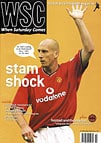 Brighton's chief executive Martin Perry talks to Andy Lyons and recalls the club's fraught period groundsharing at Gillingham and draws some parallels with Wimbledon's current situation
Brighton's chief executive Martin Perry talks to Andy Lyons and recalls the club's fraught period groundsharing at Gillingham and draws some parallels with Wimbledon's current situation
“If Brighton had had to stay at Gillingham for any longer than we did, I don’t think we would have survived. In our final season at the Goldstone (1996-97) our average gate was around 6,000. But in the first season at Gillingham gates dropped to something like 2,500. It was a 150-mile round trip for our fans, similar to that now being proposed for Wimbledon supporters. Travelling fans were setting off before lunch and getting home after eight at night.
That’s an enormous commitment and of course it also you excludes part of your fanbase, particularly the young and the elderly. We tried all kinds of incentives, like providing free coaches. In the second season it moved up to about 3,500, but much longer with those kind of crowds and the club would have been in a very poor state. Immediately we got back to Withdean, attendances shot up. Last season, with the capaity increased to 7,000, we averaged something like 6,500 and back came those other vital sectors of fanbase.
The Football League’s rules about clubs not being able to move outside their catchment area, which have now been applied in the Wimbledon case, already existed before we moved out of Brighton – first to Portsmouth – but we were given special dispensation. Specific conditions were imposed: we had to put up a performance bond of £500,000 and we had to be back in the conurbation within three years. In fact, we did it in two.
There was a good aspect to the crisis in the fact that it brought fans together for a common cause. Football clubs are made up of disparate groups of fans, and Brighton are no different from any other – there’s the official supporters’ club, unofficial clubs, regional supporters’ clubs, London-based fans and so on – and very often they battle against each other because they have got different interests. However, in our case they realised they had to come together to save the club, and the beauty of it is they stayed together. First of all it was a battle to get the planning permission to convert the Withdean Stadium. Since then, they have backed us all the way in our efforts to get our new stadium at Falmer. Allowing for a public enquiry, we’re targeting 2004 to move in there.
There were residents’ objections to our making a football ground out of this quiet little sports stadium at Withdean, and that wasn’t a surprise. Brighton is one of those places where whatever you try to do there will be somebody who will object. The residents let it be known that they were putting together a petition. We estimated they would probably get around 4,000 signatures and so we asked the fans if they could beat that, aiming at around 10,000 signatures in favour, which was more than had been attending in the last days at the Goldstone. They came back two weeks later with 32,000. And there’s no question in my mind that when they presented that petition the council suddenly realised there are an awful lot of people in Brighton who are extremely supportive of the football club and that if the council were not to support the club it would mean votes lost.
I go on about the fact that a football club isn’t just about first team performance, although that’s the core business. The impact of a club on its local com‑munity is enormous. We have 17 coaches working at six schools in Brighton and Hove, we have a special needs group of kids who played at the Millennium Stadium before the Charity Shield, we’ve set up holiday soccer schools and so on. Now we’re not unique. Football clubs all over the country do that. And those are the kind of benefits a club can bring to its community.
I do think it’s sad for Wimbledon and for Merton as a community that they could potentially lose their club, and desperately sad for the supporters. The Wimbledon story is fantastic, of where they came from and where they got to, and they have every chance now of getting back into the Premiership. The amount of time that our supporters are willing to put in to help us is just extraordinary and I’m sure that it’s the same for Wimbledon. Everybody now should be redoubling their efforts to find a solution, which means a site in Wimbledon.”
From WSC 176 October 2001. What was happening this month